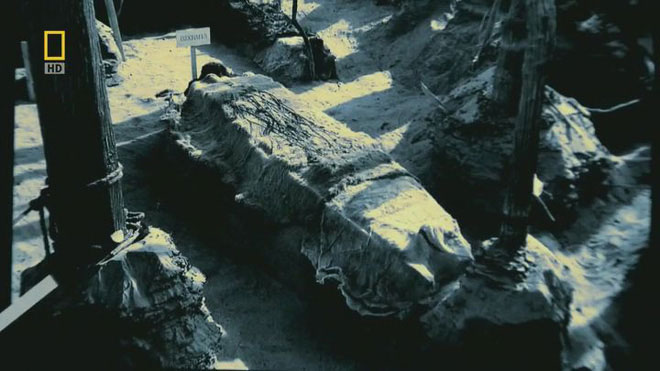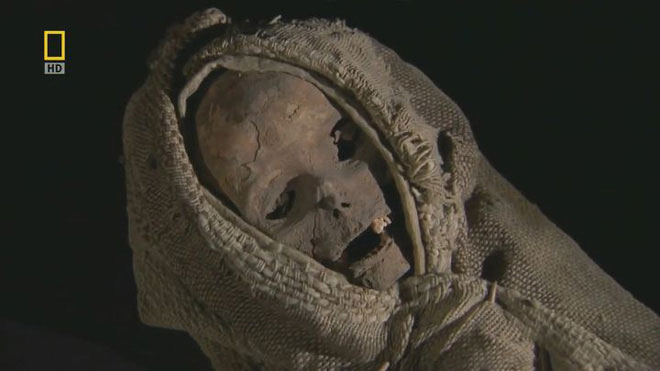Mummies in China: Did white people come to the East more than 3,000 years ago?
In fact, China does not have a tradition of mummification, but in some special natural conditions, mummies are also formed and this takes place all over the world, the most famous of which is "Human Ötzi ice ".
However, some mummies in China are not so simple. Many of them can be traced back to 4,000 years ago.
What is even more strange is that they have faces with white skin and are very different from the Chinese who live on the land found over many generations. When archaeologists began to research the origins of these people, they found it extremely difficult to understand because the mummies shared the anthropomorphic characteristics with Mesopotamians (Mesopotamia), Europe, and the West. North Asia and India.

Some mummies have white-skinned faces and are very different from Chinese.
National Geographic once produced a film that talks about the exchange and contact between the East and the West from the perspective of the Western world.
For ordinary people, people would consider the gap between the East and the West to be very large in ancient times. But there are also many descriptions of the Western world in ancient Chinese literature, but they are often unclear or simply comparing strange things in the mountains and the sea. The same thing happens to Westerners.
Before Marco Polo, the Western world was full of strange prejudices about the imagination of the East, and even modern Westerners had strange views of East Asians at the time.
However, the connection between the East and the ancient West is actually more mysterious and interesting than is often thought.
During the 1970s and 1980s, China discovered a large number of naturally dried mummies in the Tarim desert basin of Xinjiang.
The bodies are preserved in an extremely perfect environment, not only with faces and clothes, even the items they carry with them are very different and unique.

A naturally dried mummy.
In 1988, when an American scholar went to China to observe and study mummies, he discovered that the mummies' faces seemed to have similarities with him, and especially the color. skin.
Because according to previously known documents, about 3,000 years ago there was no traffic exchange or connection between the East and the West.

Why did a white man appear on Chinese soil more than 3,000 years ago?
At the time, the only bridge between the Eastern and Western worlds was across the Tarim basin from the northwest, where these white-colored mummies were unearthed.
Since the theory has been put forward, it seems these white people have settled here, but today we have no clue other than these mummies. There is no record of any ancient books, and today we have no clue that their descendants lived there.
In 1978, Chinese archaeologist Wang Binghua led an archeological team into the center of the Tarim basin, where mummies with a face of disagreement with East Asians were unearthed.
There must be a lot of people guessing that they were the ancient warriors of the Western Region or the nomadic herders who moved from the west.
And perhaps these predictions are true, because they live and settle in the desert oases of the Tarim basin, but the objects they bring are extremely strange.



From the fabric on the dress of an unearthed little mummy has brought new clues about the origin of these mummies.
The design and texture of this dress is made from European twill, which shares the same characteristics as excavations in Germany, Austria and Scandinavia.
This fabric was also recognized as a unique textile fabric in Europe, in addition to its material being mostly wool, while Chinese fabrics at that time did not have the techniques of shepherd and the fabric was usually woven with Vegetable fibers and silk.

In addition, another important clue was also found from mummies, riddles and bronze tools .
For Chinese people, mentioning copper will surely remind us of copper bells or bronze three-legged cauldron, . However, the world believes that copper smelting technology originated from Mesopotamia. . Chinese copper technology is often considered to have absorbed and learned from foreign technological innovations.
So far this issue has caused a lot of controversy, but according to archaeological sites as well as objects from these mummies, perhaps bronze appeared earlier from the West and gradually introduced. in Trung Nguyen, by the earliest bronze items found in Xinjiang.

Bone, horseshoe, saddle and clothing were also found beside these mysterious mummies. Their pants are considered to be specialized equipment developed for horse riding. Their horses also have many similarities with the horses that represent the civilization of modern Eurasian diplomacy.
People there tamed wild horses 5,500 years ago, while Chinese horses only appeared about 2,000 years ago and high probability was also brought by the West.

In addition, where these mysterious mummies were discovered, several items from Chinese civilization were unearthed, and they speculated that these people were dealing with Han Chinese in Zhongyuan through the exchange. exchange of goods.
The most amazing thing is that in the Russian Hermecca Museum, a mummified excavation in Siberia has many similarities with the mysterious mummies of Xinjiang , but the distance between the two places is 1000km.
Among the excavated items in Siberia, archaeologists also found a fabric entirely similar to the type of mummies in Xinjiang.
In addition, these two locations also detect similarities such as horses as well as the symbolic two-wheeled cars of Western culture with large, wide rims, high wheels and the largest number of spokes. , and that is also the impression of the Chinese people of the ancient West.

So where do the mysterious mummies in Xinjiang come from? Archaeological evidence shows that they do not seem to have a clear origin . Textile technology originated from Europe, copper technology comes from Mesopotamia (Mesopotamia), domesticated horses originated from the Eurasian border region and some mummies are said to be witches carrying items. Seashell decoration made from the Indian Ocean.
Therefore, in order to trace the origin of the mummies, the last hope is due to DNA analysis. Professor Jin Li of Fudan University said: "Although these mummies are preserved in an almost perfect environment, thousands of years are enough to destroy most of the genetic material, so the analysis DNA is hard to succeed. "
But after much effort, Professor Jin Li's group finally extracted the muscle tissue available inside a mummy's thigh.

After analysis, these genetic traits come from Eastern Europe, the Middle East, Siberia, Tibet, Mongolia, India and even East Asia, which can be said to be a mixed ethnic group.
The migration of ethnic groups from across Eurasia has brought about different cultures and technologies.
Professor Jin Li believes that the Tarim basin is the main path for the migration of ancient ethnic groups to the east. No exaggeration to say that this is the convergence of the ancient nation.

- Ancient people also suffered from atherosclerosis
- The most exotic ancient mummies in Vietnam
- The mysterious mummy survived for thousands of years, suddenly ... liquefied
- Successfully deciphered the tiny red face of ancient Egypt
- Mummies grafted from parts of many people
- The secrets of mummies
- Cure obesity with ... mummy intestines
- Discover the mummy of women aged 4,500 years in Peru
- China causes serious oil spill to the east bay
- Mysterious mummies in Vietnam
- Special mummies in the world
- China spent $ 22 million to study the East Sea
 Discovered an ancient centipede fossil 99 million years old
Discovered an ancient centipede fossil 99 million years old Discovered bat-like dinosaurs in China
Discovered bat-like dinosaurs in China Discovered a 200-year-old bronze cannon of the coast
Discovered a 200-year-old bronze cannon of the coast Discover 305 million-year-old spider fossils
Discover 305 million-year-old spider fossils